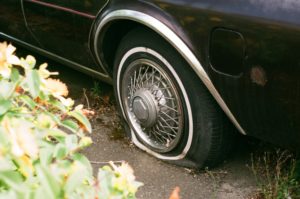
By Heather N. Kolich, County Extension Coordinator, UGA Extension Forsyth County, October 2022
I had a blow-out on GA-20. Traffic was heavy, and the right shoulder was demolished for road widening. I limped along until I found a mostly level gravel lot on the opposite side of the road and pulled in to change the tire.
I’ve changed a flat tire before, but not in that car or with that equipment. Had I practiced before an emergency struck, I would have been more confident, and therefore quicker, with placement and operation of the jack. I would also have known that the manufacturer-supplied lug wrench was not strong enough to loosen machine-tightened lug nuts.
Having the stuff is not enough
Gathering supplies is an important piece of emergency preparedness, but having the stuff is not enough. Our chances of survival and self-rescue after an accident are much better when we can get to and effectively use the tools and materials we’ve designated for emergency response, and when we’re mentally prepared to act and succeed. Planning, preparation, and practice help make that happen.
Planning. Emergency planning starts with risk identification. Flat tires are a predictable roadway risk. Vehicle malfunction, such as losing the brakes on I-75, is another risk I’ve experienced. Are we due for another Snowmageddon? I once heard a news story about a woman who survived several days trapped in her car after it slid off the road into a ravine.
Thankfully, I haven’t experienced that, but it prompted me to think through what I’d need if my car leaves the roadway and vanishes from view. For survival: water, warmth, first aid, food, and a way to signal or call for help. For self-rescue: tools to escape the car, work gloves, warm socks and sturdy boots, a brightly colored or reflective coat, a flashlight with functioning batteries, plus the survival items and a way to carry them with me.
Preparation. In addition to gathering supplies to get through an emergency, preparation involves taking actions to reduce risks. For example, before I started my journey on GA-20, I had my car serviced, including tire inspection and rotation, to reduce the chances of vehicle malfunction. On the road, I kept a 2-car distance between my car and the truck in front of me to reduce the risk of collision. It was in that safe distance space that I watched the road construction debris fly out from under the truck’s flatbed and bounce twice before it punctured my tire. While I couldn’t eliminate the risk of a flat tire, I mitigated further risk by finding a safe place to pull off the road to change the tire.
Practice. Mental preparation is just as important as physical preparation for surviving an emergency. Mentally working through how to respond to different emergency situations and physically practicing those plans can show what works,
what doesn’t, and what’s missing. I joke that I have plans A, B, and C-1, C-2, C-3 for a variety of emergencies, but it’s not really a joke. In one scenario, I’m stuck in the driver’s seat. Is the tool that cuts the safety belt somewhere I can reach it? If I put that tool in the driver’s door pocket, will it stay there if the car rolls over? Where can my water, food, and blanket be securely stored in arms-reach in the passenger cabin? What should go in the cargo area? If I’m stranded and need to hike out, how much weight can I carry in my backpack?
We can’t eliminate all risk or avoid all roadway accidents, but planning, preparation, and practice give us stronger control over the outcome of emergency incidents. For more information on preparing for roadway emergencies, visit Ready.gov and the National Safety Council.